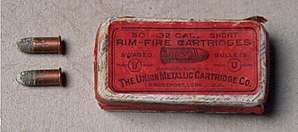.32 rimfire
The term .32 rimfire refers to a family of cartridges which were chambered in revolvers and rifles in the late 19th and early 20th centuries. These rounds were made primarily in short and long lengths, but extra short, long rifle and extra long lengths were offered.[1]
| .32 Short | ||||||||
|---|---|---|---|---|---|---|---|---|
 | ||||||||
| Type | Pistol/rifle | |||||||
| Place of origin | United States | |||||||
| Production history | ||||||||
| Designer | Smith & Wesson | |||||||
| Designed | 1860 | |||||||
| Specifications | ||||||||
| Case type | Rimmed, straight[1] | |||||||
| Bullet diameter | .316 in (8.0 mm) | |||||||
| Neck diameter | .318 in (8.1 mm) | |||||||
| Base diameter | .318 in (8.1 mm) | |||||||
| Rim diameter | .377 in (9.6 mm) | |||||||
| Case length | 0.575 in (14.6 mm) | |||||||
| Overall length | 0.948 in (24.1 mm) | |||||||
| Primer type | rimfire | |||||||
| Filling | Black Powder, later smokeless powder | |||||||
| Ballistic performance | ||||||||
| ||||||||
| Test barrel length: 24 | ||||||||
| .32 Long | ||||||||
|---|---|---|---|---|---|---|---|---|
| Type | Rifle | |||||||
| Place of origin | United States | |||||||
| Production history | ||||||||
| Designer | Smith & Wesson | |||||||
| Designed | 1860 | |||||||
| Specifications | ||||||||
| Case type | Rimmed, straight[1] | |||||||
| Bullet diameter | .316 in (8.0 mm) | |||||||
| Neck diameter | .318 in (8.1 mm) | |||||||
| Base diameter | .318 in (8.1 mm) | |||||||
| Rim diameter | .377 in (9.6 mm) | |||||||
| Case length | 0.791 in (20.1 mm) | |||||||
| Overall length | 01.26 in (32 mm) | |||||||
| Primer type | rimfire | |||||||
| Filling | Black powder, later smokeless powder | |||||||
| Ballistic performance | ||||||||
| ||||||||
| Test barrel length: 24 | ||||||||
| .32 Extra Long | ||||||||
|---|---|---|---|---|---|---|---|---|
| Type | Rifle | |||||||
| Place of origin | United States | |||||||
| Specifications | ||||||||
| Case type | Rimmed, straight[1] | |||||||
| Bullet diameter | .316 in (8.0 mm) | |||||||
| Neck diameter | .318 in (8.1 mm) | |||||||
| Base diameter | .318 in (8.1 mm) | |||||||
| Rim diameter | .377 in (9.6 mm) | |||||||
| Case length | 1.150 in (29.2 mm) | |||||||
| Overall length | 01.26 in (32 mm) | |||||||
| Primer type | rimfire | |||||||
| Filling | Black powder, later smokeless powder | |||||||
| Ballistic performance | ||||||||
| ||||||||
| Test barrel length: 24 | ||||||||
Manufacturers
Manufacturers in the USA generally discontinued making .32 rimfire ammunition after the country's entrance into World War II in 1941.[1] It was available from old stocks for some years afterwards, but it has been made only sporadically in the last 70 years.[1] Occasionally, special limited runs of .32 rimfire ammunition are manufactured for gun collectors with shootable specimens, but the round is not considered a current commercial cartridge. Navy Arms Company had periodically imported .32 Rimfire Long made by CBC in Brazil until 2014.[2]
History
The .32 Short was designed in 1860 by Smith & Wesson for their Model 2 revolver. In 1868, they introduced the .32 Long in the Model 1½ Second Issue revolver.[3]
The .32 Short fired an 80 gr (0.183 oz; 5.184 g) lead bullet at 945 ft/s (288 m/s) (generating 159 ft⋅lb (216 J) muzzle energy) from a 24 in (61 cm) rifle barrel. The .32 Long fired a slightly heavier 90 gr (0.206 oz; 5.832 g) bullet at approximately the same velocity, for 178 ft⋅lb (241 J) muzzle energy. Remington rifles in .32 rimfire listed a bore diameter of .304 in (7.7 mm)[4]
The .32 Short and Long rimfire cartridges matched the external dimensions of the .32 Colt Short and Long centerfire cartridges; the Marlin Model 1891 lever-action repeating rifle was shipped with two firing pins, one rimfire and one centerfire, to allow use of either the rimfire or centerfire cartridges.[5] Revolvers and single shot rifles chambered for one of the longer .32 rimfire cartridges would chamber and fire the shorter cartridges.[1]
Remington Arms manufactured .32 Extra Short ammunition (also known as .32 Protector) until 1920 for use in the Protector Palm Pistol and Remington Magazine Pistol.[6]
During its lifetime, the .32 rimfire was loaded with black powder, followed by semi-smokeless and smokeless powder loadings. While it was popular as a very effective small game caliber, it was considered obsolete by the late 1930s, in part due to the introduction of high-velocity versions of the .22 Long Rifle using smokeless powder.[1]
References
- Barnes, Frank C. (1997). M.L. McPherson (ed.). Cartridges of the World (8th ed.). p. 386. ISBN 0873491785.
- Woodard, W. Todd (1 December 2014). Cartridges of the World: A Complete and Illustrated Reference for Over 1500 Cartridges. Iola, Wisconsin: F+W Media. pp. 1768–1769. ISBN 978-1-4402-4274-8.
- Kinard, Jeff (2004). Pistols: An Illustrated History of Their Impact. ABC-CLIO. p. 115. ISBN 978-1851094707.
- Sharpe, Phillip B. The Rifle in America (William Morrow and Co., 1938).
- Sears, Roebuck and Co. Catalogue No. 104, 1897.
- Barnes, Frank C. (22 September 2009). Cartridges of the World: A Complete and Illustrated Reference for Over 1500 Cartridges. Iola, Wisconsin: Gun Digest Books. p. 447. ISBN 1-4402-1330-5.